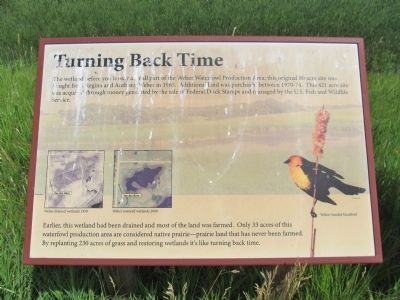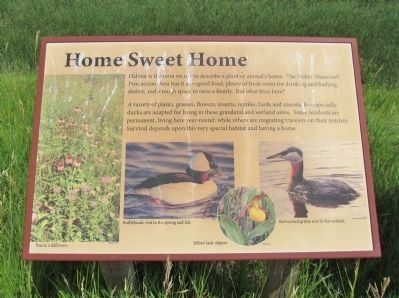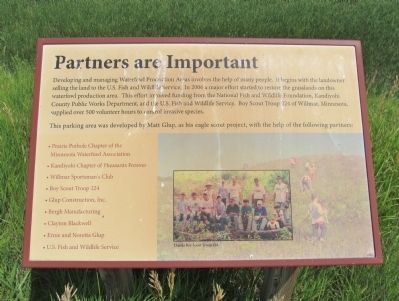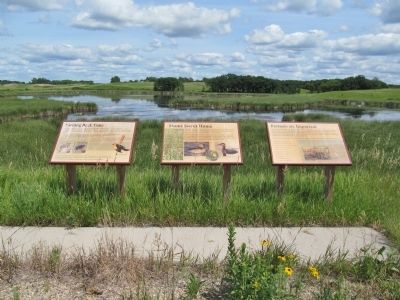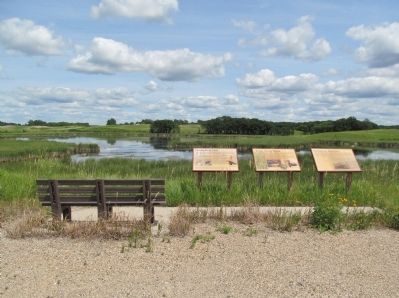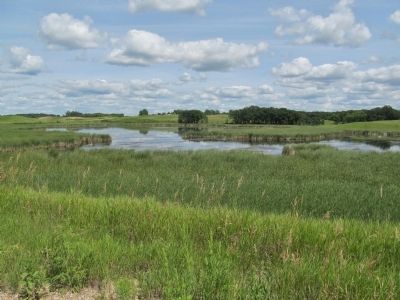Near Willmar in Kandiyohi County, Minnesota — The American Midwest (Upper Plains)
Turning Back Time
The wetland before you is only a small part of the Weber Waterfowl Production Area; this original 80 acre site was bought from Regina and Anthony Weber in 1965. Additional land was purchased between 1970-74. This 421 acre site was acquired through money generated by the sale of Federal Duck Stamps and managed by the U.S. Fish and Wildlife Service.
Earlier, this wetland had been drained and most of the land was farmed. Only 33 acres of this waterfowl production area are considered native prairie — prairie land that has never been farmed. By replanting 230 acres of grass and restoring wetlands it's like turning back time.
Habitat is the term we use to describe a plant or animal's home. The Weber Waterfowl Production Area has it all — good food, plenty of fresh water for drinking and bathing, shelter, and enough space to raise a family. But what lives here?
A variety of plants, grasses, flowers, insects, reptiles, birds and mammals — especially ducks are adapted for living in these grassland and wetland areas. Some residents are permanent, living here year-round; while others are migrating travelers on their journey. Survival depends upon this very special habitat and having a home.
Developing and managing Waterfowl Production Areas involves the help of many people. It begins with the landowner selling the land to the U.S. Fish and Wildlife Service. In 2006 a major effort started to restore the grasslands on this waterfowl production area. This effort involved funding from the National Fish and Wildlife Foundation, Kandiyohi County Public Works Department, and the U.S. Fish and Wildlife Service. Boy Scout Troop 224 of Willmar, Minnesota, supplied over 500 volunteer hours to control invasive species.
This parking area was developed by Matt Glup, as his eagle scout project, with the help of the following partners:
Prairie Pothole Chapter of the Minnesota Waterfowl Association
Kandiyohi Chapter of Pheasants Forever
Willmar Sportsman's Club
Boy Scout Troop 224
Glup Construction, Inc.
Bergh Manufacturing
Clayton Blackwell
Ernie and Noretta Glup
U.S. Fish and Wildlife Service
Topics. This historical marker is listed in these topic lists: Animals • Environment • Waterways & Vessels. A significant historical year for this entry is 1965.
Location. 45° 10.828′ N, 95° 4.674′ W. Marker is near Willmar, Minnesota, in Kandiyohi County. Marker is on 30th Street Northwest (County Highway 5) 0.1 miles south of 60th Avenue Northwest (County Highway 25), on the left when traveling south. Marker is 2.9 miles north of 37th Avenue Northwest (County Road 92). Touch for map. Marker is in this post office area: Willmar MN 56201, United States of America. Touch for directions.
Other nearby markers. At least 8 other markers are within 4 miles of this marker, measured as the crow flies. Guri Endresen-Rosseland (approx. 0.4 miles away); Welcome to the Endreson Cabin (approx. 1.4 miles away); Haugen Homestead (approx. 1.8 miles away); The Erickson Cabin (approx. 2.7 miles away); Kandiyohi County's First Church (approx. 2.7 miles away); Fullerville (approx. 3.2 miles away); Foot Cabin (approx. 3.2 miles away); Grasshopper Plague (approx. 3.6 miles away). Touch for a list and map of all markers in Willmar.
More about this marker. captions:
Water drained wetlands 1938
Weber restored wetlands 2008
Yellow-headed blackbird
Prairie wildflowers
Buffleheads visit in the spring and fall.
Yellow lady slipper
Red-necked grebes nest in this wetland.
Thanks Boy Scout Troop 224
Also see . . . Litchfield Wetland Management District. U.S. Fish & Wildlife Service website entry (Submitted on October 5, 2014.)
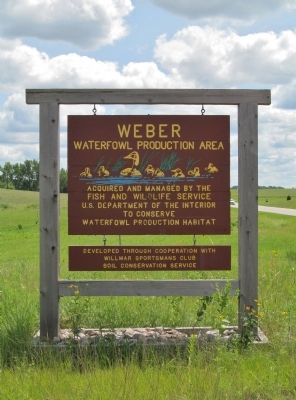
Photographed By K. Linzmeier, July 16, 2014
7. Weber Waterfowl Production Area Sign
Acquired and Managed by the
Fish and Wildlife Service
U.S. Department of the Interior
to Conserve
Waterfowl Habitat
Developed through cooperation with
Willmar Sportsman's Club
Soil Conservation Service
Credits. This page was last revised on April 21, 2022. It was originally submitted on October 5, 2014, by Keith L of Wisconsin Rapids, Wisconsin. This page has been viewed 638 times since then and 23 times this year. Photos: 1, 2, 3, 4, 5, 6, 7. submitted on October 5, 2014, by Keith L of Wisconsin Rapids, Wisconsin.
